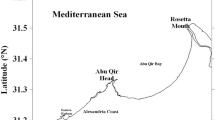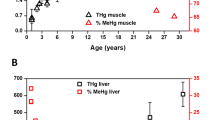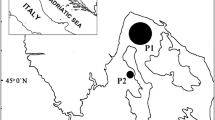Abstract
HIGH levels of mercury may occur in the tissues of seals, dolphins and porpoises1–4. In the Netherlands from 225 to 765 p.p.m. (wet weight) in liver and from 9.9 to 31 p.p.m. in brain have been detected in adult specimens of the common seal (Phoca vitulina) which were found dead4. Brain concentrations were of the same order as those in the brain tissue of animals of various species poisoned experimentally by methyl-mercury compounds5. As most of the mercury in marine fish is present as methylmercury5, the high levels in seal brain suggest that these animals are affected by the toxic action of methylmercury compounds. Analyses of the methylmercury levels according to Westöö6 in the livers of six seals shot in the German part of the Wadden Sea and two adults found dead showed that only 2 to 14% of the total mercury was methylmercury. Similarly, of the 10 and 15 p.p.m. total mercury in the brain of the latter two seals, only 2.2 and 13% respectively could be recovered as methylmercury. Neutron activation analysis of the tissue precipitate remaining after benzene extraction of the acidified homogenates obtained in the methylmercury analysis has shown that on average more than 90 % of the mercury remains attached to the tissue components. In humans and in experimental animals poisoned by methylmercury compounds most or probably all mercury is in the form of methylmercury (refs 7 and 8 and S. Skerfving, report by the Department of Environmental Hygiene, Karolinska Institute, Stockholm). Thus the mechanism of binding of mercury to the tissues of seals may be different.
This is a preview of subscription content, access via your institution
Access options
Subscribe to this journal
Receive 51 print issues and online access
$199.00 per year
only $3.90 per issue
Buy this article
- Purchase on Springer Link
- Instant access to full article PDF
Prices may be subject to local taxes which are calculated during checkout
Similar content being viewed by others
References
Pearce, P. A., Gruchy, J. M., and Keith, J. A., Pesticide Section Canadian Wildlife Service, Manuscript Reports, No. 24 (1973).
Helminen, M., Karppanen, E., and Koivisto, J. I., Suom. Eläinlääkärilehti, 74, 87 (1968).
Henriksson, K., Karppanen, E., and Helminen, M., Nord. hyg. Tidskr., 50, 54 (1969).
Koeman, J. H., Peeters, W. H. M., Smit, C. J., Tjioe, P. S., and de Goeij, J. J. M., TNO-nieuws, 27, 570 (1972).
Nord. hyg. Tidskr., Suppl. 4 (1971).
Westöö, G., Acta Chem. Scand., 21, 1780 (1967).
Sumino, K., Kobe J. med. Sci., 14, 131 (1968).
Hanko, E., Erne, K., Wanntorp, H., and Borg, K., Acta Vet. Scand., 11, 268 (1970).
Tjioe, P. S., de Goeij, J. J. M., and Houtman, J. P. W., Proc. Fourth Cong. on Modern Trends in Activation Analysis (Saclay, 1972).
Ganther, H. E., Goudie, C., Sunde, M. L., Kopecky, M. J., Wagner, P., and Sang-Hwan Oh, Hoekstra, W. G., Science, N. Y., 175, 1122 (1972).
Robertson, D. E., Rancitelli, L. A., Langford, J. C., and Perkins, R. W., Workshop Sponsored by the National Science Foundation's Office for the International Decade for Oceanographic Exploration (Brookhaven National Laboratory, Upton, New York, May 24–26, 1973).
Lunde, G., J. Sci. Fd Agric., 19, 432 (1968).
Parízek, J., and Ostádalová, I., Experientia, 23, 142 (1967).
Parízek, Benes, I., Ostádalová, I., Babicky, A., Benes, J., and Lener, J., Physiologia bohemoslov., 18, 95 (1969).
Parízek, J., Ostádalová, I., Kalousková, J., Babicky, A., and Benes, J., in Newer Trace Elements in Nutrition (edit. by Mertz, W., and Cornatzer, W. E.), chap. 6 (Dekker, New York, 1971).
Author information
Authors and Affiliations
Rights and permissions
About this article
Cite this article
KOEMAN, J., PEETERS, W., KOUDSTAAL-HOL, C. et al. Mercury-Selenium Correlations in Marine Mammals. Nature 245, 385–386 (1973). https://doi.org/10.1038/245385a0
Received:
Revised:
Issue Date:
DOI: https://doi.org/10.1038/245385a0
This article is cited by
-
Translational toxicology of metal(loid) species: linking their bioinorganic chemistry in the bloodstream to organ damage onset
BioMetals (2023)
-
Mercury–Selenium Accumulation Patterns in Muscle Tissue of Two Freshwater Fish Species, Eurasian Perch (Perca fluviatilis) and Vendace (Coregonus albula)
Water, Air, & Soil Pollution (2022)
-
Heavy metals and metalloid levels in the tissues of yellow-legged gulls (Larus michahellis) from Spain: sex, age, and geographical location differences
Environmental Science and Pollution Research (2022)
-
Analysis of essential and non-essential trace elements in the organs of a mother–fetus pair of spotted seals (Phoca largha) from the Sea of Japan
Environmental Science and Pollution Research (2021)
-
Mechanistic understanding of MeHg-Se antagonism in soil-rice systems: the key role of antagonism in soil
Scientific Reports (2016)
Comments
By submitting a comment you agree to abide by our Terms and Community Guidelines. If you find something abusive or that does not comply with our terms or guidelines please flag it as inappropriate.



